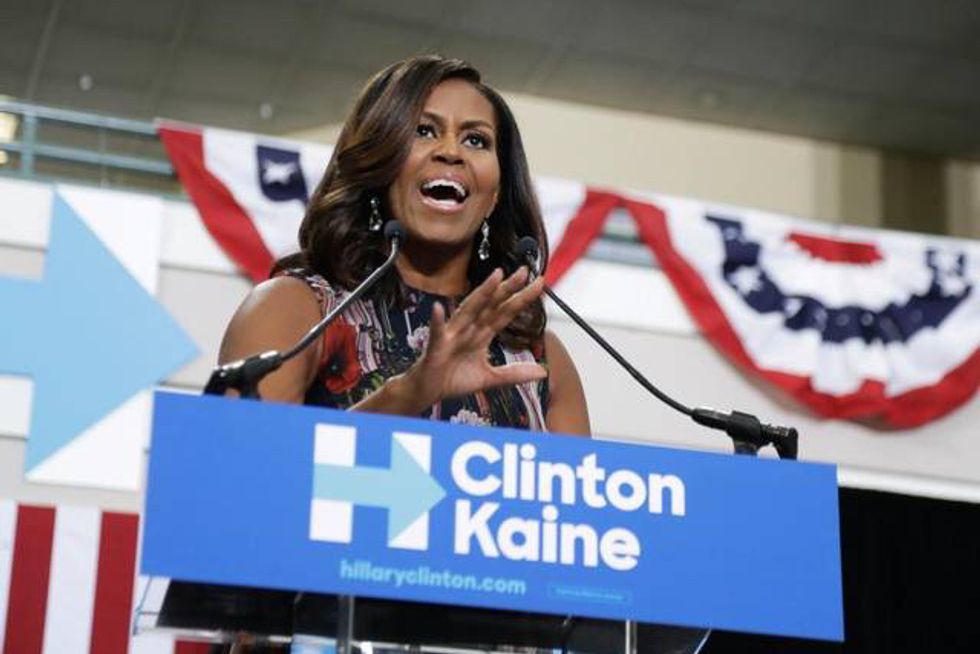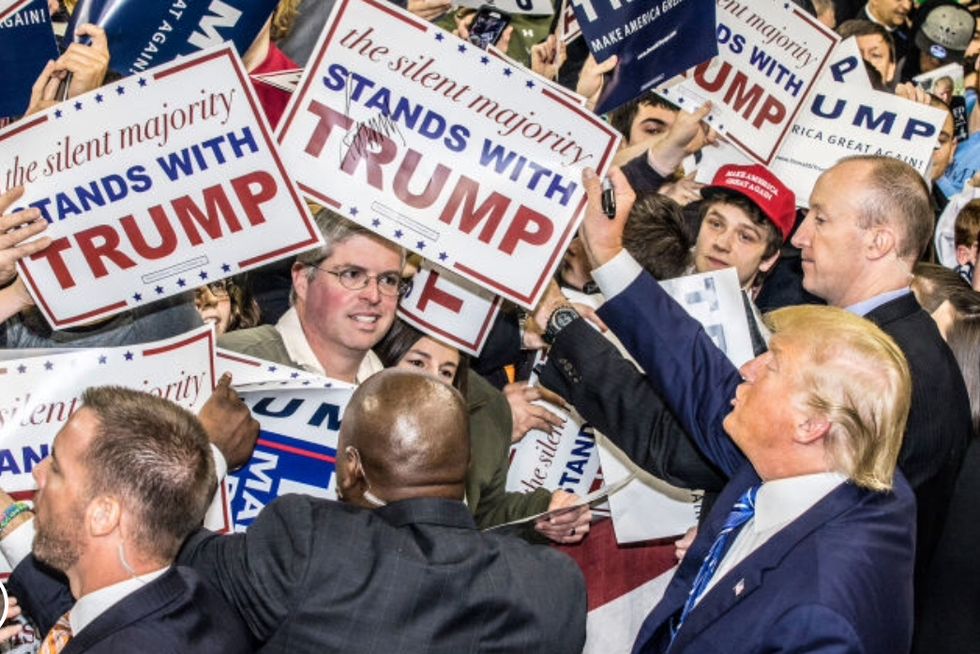Michelle Obama spoke for Hillary at George Washington University in Virginia on Friday, September 16.
As she said -"Elections aren't just about who votes, but who doesn't vote. And that is especially true of young voters like you," she said to the crowd at George Mason University. "In fact in 2012 voters under the age of 30 provided the margin of victory for Barack in four key battleground states: Pennsylvania, Ohio, Florida, and right here in Virginia."
She got specific, telling the audience that Obama won his 2012 re-election campaign over Mitt Romney by just 31 votes per precinct in Virginia, nine votes per precinct in Ohio, and six votes per precinct in Florida. Again, this seemed like an incredibly effective message to any would-be Democratic voter who was considering voting for Green Party candidate Jill Stein or skipping the election because of dislike for Hillary.
If Michelle doesn't persuade you, maybe the two commentary below will by John Cassidy in The New Yorker.
Be strong. Be very strong. Then work for Hillary and VOTE.
-------------------
THE BIG QUESTION ABOUT DONALD TRUMP'S RISE IN THE POLLS by John Cassidy (from the New Yorker, September 16, 2016)
Of all the opinion polls that have come out in the past few days, one in particular caught my eye. It was carried out in Michigan for the Detroit Free Press and WXYZ-TV, a Detroit station, and it showed that, in the past month, Hillary Clinton's lead over Donald Trump in the Great Lakes State has narrowed from ten points to four points in a head-to-head matchup. "The race is tightening a lot in Michigan," Bernie Porn, the pollster who carried out the statewide telephone survey, told the Free Press. "It may be a function of the timing of the survey and her health questions, [but] there has been a shift toward Trump. Whether it's going to be a permanent shift is yet to be determined."
If that line of thinking goes for Michigan, a state that hasn't voted Republican in a Presidential contest since 1988, it also goes for much of the rest of the country. On August 10th, Hillary Clinton was leading Donald Trump by almost eight percentage points in a head-to-head match, according to the Real Clear Politics poll average. By Friday morning, the gap had narrowed to 1.5 percentage points. A poll from CBS News and the New York Times showed that Trump had pulled to within two points of Clinton among likely voters. A Fox News survey of likely voters showed Clinton leading by one point in a four-way race including two third-party candidates—Gary Johnson and Jill Stein. But the poll also showed Trump leading by one point in a head-to-head match up with Clinton.
For Clinton supporters, the narrowing in the national polls is deeply worrying, and the trends in Michigan and other battleground states, where Clinton appeared to have a formidable advantage just a few weeks ago, are even more alarming. Since the start of September, the polls have flipped in Florida, Iowa, and Ohio. It looks like they might be about to flip in North Carolina, and they are narrowing in Michigan, Pennsylvania, and Virginia. If Trump carries the first four of these states and also picks up one of the others, he could well get to two hundred and seventy votes in the Electoral College.
The big unknown, as Porn indicated, is whether Trump's surge will be a temporary phenomenon. Political scientists and polling experts generally agree that big shifts in the polls can usually be attributed to two interrelated factors: real shifts in voter sentiment, and statistical outcomes that result from what experts call differential response. "When candidates are doing badly, and they have a lot of bad news, some of their supporters don't respond to surveys," Ruy Teixeira, a senior fellow and polling expert at the Democratic-leaning Center for American Progress, explained to me. These changes in response rates can serve to amplify and exaggerate underlying swings. "We can be pretty sure some of that is going on," Teixeira said.
Like the Michigan poll I started out with, most of the latest campaign surveys were carried out during last weekend and earlier this week, when the news was dominated by Clinton's stumble outside Ground Zero, which prompted the campaign to reveal that she had pneumonia. That incident came a couple of days after she caused a furor by describing half of Trump's supporters as a "basket of deplorables." As Teixeira put it, "this is a particularly bad time for Hillary Clinton."
The very fact that Clinton is now back campaigning should change the tone of the news coverage of her, which, in turn, should encourage more of her supporters to respond to voter surveys. And it's also worth considering, in my opinion, how voters who are not currently supporting Clinton, or whose support for her is so weak they might not turn out and vote, respond to the Trump surge. Indeed, it's easy to imagine that this could be key to what happens on November 8th.
Up to this point, the prospect of Trump entering the White House had been a distant one. Now that it has become a genuine possibility, there could well be a counterreaction. And if Trump were to take a lead in the polls, this response could be a substantial one. Some people who have been flirting with voting for Trump, never thinking he could win, could change their minds. More important, a lot of progressives and independents who were thinking of voting for a thirty-party candidate, or of not voting at all, could switch to Clinton in order to keep Trump out. That could tip the race back in Clinton's direction.
Election campaigns are complicated processes that aggregate the actions of countless individuals. Like many such processes that occur in the physical and human worlds, elections can exhibit positive feedback and negative feedback. Positive feedback is the electoral equivalent of a rock slide. A candidate establishes a lead in the polls, which generates a lot of positive news coverage for him or her, and that persuades other people to jump on the bandwagon. Negative feedback is like a heating and ventilation system that moderates temperatures. When someone gets a big lead in the polls, voters start to inspect him or her more seriously, and some of them have second thoughts. Theoretically, Trump's rise could generate a positive feedback or a negative feedback—the biggest question in the campaign now is which one it will be. My hunch (and hope) is it will be negative feedback.
Until now, the campaign has unfolded against a backdrop of consensus that Trump will lose. In mid-June, fifty-five per cent of respondents to a CNN/ORC poll said that they expected Clinton to win, and thirty-eight per cent said that they expected Trump to win. At the start of this month, fifty-nine per cent of respondents to the same poll said they thought Clinton would win; just thirty-four per cent said Trump would. In an environment where Trump was expected to lose, an individual's decision to embrace him, or abandon Clinton, could well seem like a costless one: If Clinton's going to win anyway, does it really matter what I do?
But now the complacent belief that Trump is unelectable has been shattered. On Friday, Five Thirty Eight's "polls-only" model estimated that the probability of him winning was about forty per cent. Even Democratic polling experts, such as Teixeria, concede that a Trump victory is possible. To be sure, they qualify this in many ways, noting that Trump would need to run the table in his target states, getting a huge turnout of white non-college voters and a low turnout in Democratic-leaning demographics. But, as Teixeria said to me, "there is a path."
In this new environment, the stakes are a lot higher, and voters will be forced to think more seriously about the consequences of their decisions, including the decision about whether to vote at all. Consider the ten to fifteen per cent of respondents who tell pollsters that they are still making up their minds. Or the roughly one in three millennials who, according to some recent polls, are planning to support Gary Johnson or Jill Stein. Or the fifty-seven per cent of registered Democrats who say that they are less enthusiastic than usual about voting this year. How many of these people will want to have it on their consciences that, either by voting for someone other than Clinton or by not showing up at all they helped to elect President Trump?
Some of those people might still sit it out, but my guess is not very many. There is little evidence that Trump's gains have been accompanied by any wholesale revision of voters' opinions of him. According to the most recent Washington Post/ABC News poll, just thirty-six per cent of Americans think he is qualified to be President, and sixty-two per cent think he isn't. (In the same poll, sixty per cent of voters said Clinton is qualified and thirty-nine per cent said she isn't.) Other polls have produced similar findings. After consulting some historical data, the Washington Post's Greg Sargent wrote, earlier this week, that "Trump fares worse than even Sarah Palin did on perceptions of the level of qualification for the presidency. The only figure who had worse rankings on this than Trump was poor Dan Quayle."
Of course, some people might vote for Trump even though they consider him unqualified—perhaps because they think Clinton is even less qualified, or because they simply dislike her. But Trump still faces a basic conundrum: How can you win an election when your approval rating is under forty per cent and your disapproval rating is the highest of any Presidential candidate in recent history?
In the past couple of weeks, thanks to more discipline on his part—along with disaffected Republicans returning to the fold, and some assists from the Clinton campaign—it has looked like Trump may have found a way to square the circle. But now that the prospect of him sitting in the Oval Office is a more real and salient one, the dynamics of the contest are different. And they could well turn against him.
####
September 18, 2016



